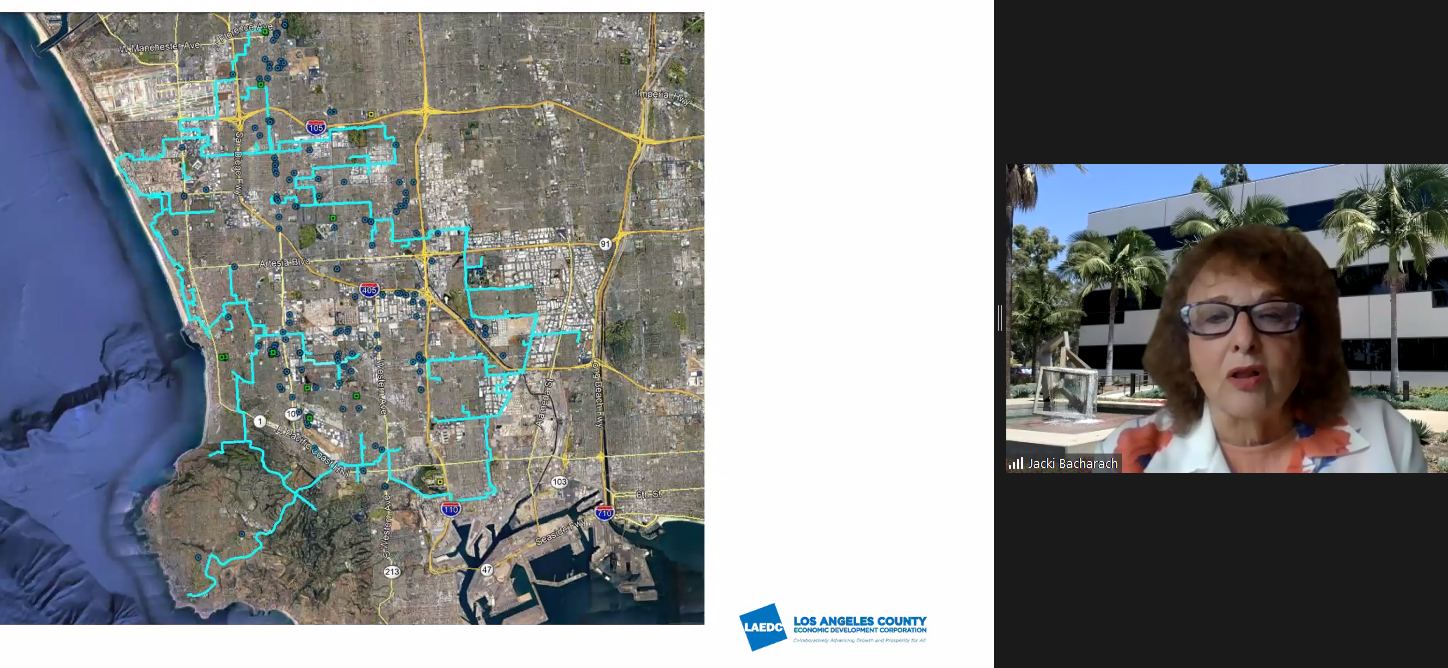LAEDC’s 88 Cities Summit, in its third year, addressed economic development challenges our cities and unincorporated communities face, with a program designed to help local government leaders develop strategies and solutions.
This year’s topic of Achieving Inclusive Economic Recovery for our Region was addressed by expert speakers who offered new options and new partners to advance progress on some of the more complex challenges in our regional economy: community-wide internet connectivity strategies to close the digital divide; business re-opening, recovery and reinvention tools to help cities assist their local small business recovery efforts; workforce development programs to help connect displaced workers and other job seekers with training and hiring opportunities.
WATCH VIDEOS OF THE EVENT
The videos contain a level of detail not captured in the text recap below
Framing the Conversation – Opening Remarks and Context
Session 2 – LABOR MARKET SOLUTIONS – Reengaging the Workforce
Session 1 – DIGITAL SOLUTIONS: Steps to Community Wide Internet Connectivity
Session 3 – ENTERPRISE SOLUTIONS: Business-Friendly Reopening
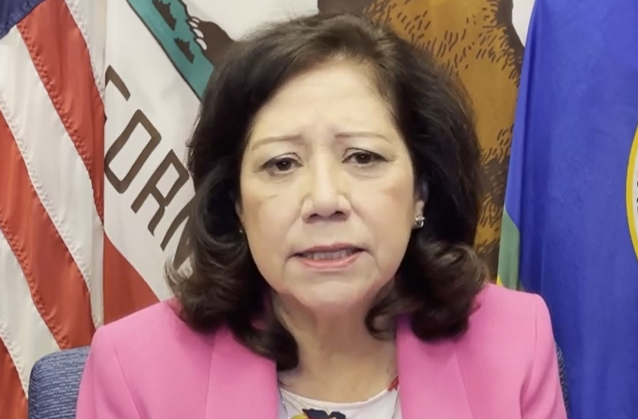
LA County Supervisor Hilda Solis
LA County Supervisor Hilda Solis made welcoming remarks and talked about the hundreds of millions of dollars in relief grants to businesses and nonprofits that the County provided this past year and reminded attendees that the LA Regional COVID Fund is still available in that role. She also advocated for closing the digital divide and highlighted President Biden’s proposed federal infrastructure investment to expand internet access which would create opportunities for the LA County region.
Bill Allen, CEO of LAEDC discussed the state of the economy, and reminded us that even before the pandemic struck, LA County had high levels of unemployment and poverty. He framed the summit as an opportunity to connect and share resources to work towards a more equitable economy, and he cited the LAEDC Pathways report as a valuable tool to frame the conversation.
Over 770,000 people lost their jobs at the start of the pandemic, and even now the region still has over 10% unemployment. Mr. Allen talked about the LAEDC response with our Business Assistance program and Community Connectory resources which enabled LAEDC’s staff to directly assist thousands of small businesses. He emphasized that the digital divide was revealed as one of the most severe issues of the pandemic, and lack of access to broadband internet disrupted education, jobs, access to vital services and access to opportunity. Another issue of equity related to the pandemic is that those who lost jobs were disproportionately younger workers, women, and people of color.
Mr. Allen continued by stating that thousands of businesses have closed, and still hundreds of thousands of LA County’s residents remain unemployed. Shifts towards e-commerce, telehealth and streaming that were expected to take years, happened over the course of several months, which will require reinvention of our businesses and economy. He emphasized the need to reinvest in retraining of our workforce at levels we have never seen before. Collaboration will be needed to stimulate job creation, help our workforce and invest in the resilience of our people and small businesses.
SESSION 1 – DIGITAL SOLUTIONS: Steps to Community Wide Connectivity
Mr. Allen announced LA Digital Equity Action League (LA DEAL) which is the new collaborative initiative that will facilitate progress in our region and will focus on broadband infrastructure deployment, affordability, digital literacy, computing devices, and policy and advocacy. He mentioned that local governments are doing some great work, developing new models such as the municipal fiber network developed and deployed in the South Bay of LA County, which is becoming a national model. He introduced the panel of experts and kicked off the discussion.
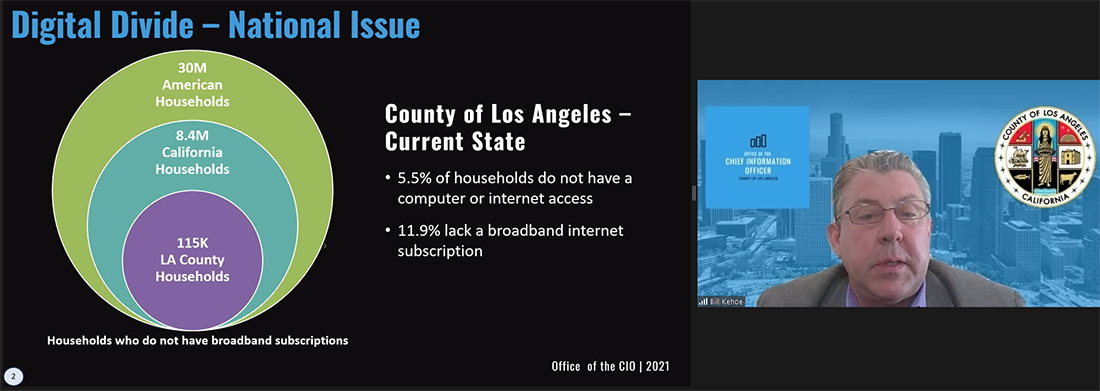
Bill Kehoe, Chief Information Officer, County of Los Angeles
Bill Kehoe, Chief Information Officer, County of Los Angeles: Mr Kehoe said the need for remote learning, remote work and remote health services exacerbated the issues of inequity and poverty during this pandemic, and the County Board of Supervisors has put forth motions to address the problem. The approach being taken by the County is to prioritize equity, sustainable solutions, security and privacy, and an inclusive approach that integrates feedback from all our communities. An internal action plan and a regional long-term strategy are both in development. County of Los Angeles is aggregating initiatives from all 37 departments that have programs in place and will be looking for gaps that can be filled. He outlined the org chart for this initiative and indicated that private stakeholders have a major role to play.
Scott Longhurst, Governmental Affairs Manager, Crown Castle: Crown Castle is the nation’s largest owner-operator of shared telecom infrastructure and Mr. Longhurst suggested that solving the digital divide is a challenge for cities, but through collaboration – use of shared conduit, light poles and other city infrastructure – cities can lever shared resources to collaborate on solutions that benefit the community.
He cited two examples. In mountainous areas of Utah with historically bad connectivity, Crown Castle laid fiber, built small cell facilities, and made that fiber available to Utah DOT, which they used at Crown Castle’s small cell locations. Now, all the region’s carriers use that fiber and it enhanced connectivity in that part of the state, as well as helping DOT with traffic management. In a second example, Mr. Longhurst said Washington D.C. is deploying a municipal Wi-Fi network, and Crown Castle agreed to install Wi-Fi devices as it installs its equipment. He also described a city approval process called a “term permit” which allowed faster completion and reduced the administrative overhead for the city. He expects a surge in communications construction and said the company is partnering with community colleges to add telecom training into the curriculum such as fiber splicing. See the video for more details on Mr. Longhurst’s comments.
Jackie Bacharach, Executive Director, South Bay Cities Council of Governments: Ms. Bacharach said there was concern about lack of broadband capacity resulting in some businesses leaving the region. Her team hosted a lot of lunch-and-learns to understand what was going on with the internet. As they continued research, they learned that the public sector hadn’t laid enough fiber in the region. Her team also found that cities were purchasing a lot less bandwidth than needed and overpaying, with cities paying an average of $4,000 per month.
The next step was an RFP in 2018 to understand how to future-proof the system to manage the increasing need for broadband. American Dark Fiber became the key partner and pieced together a network from existing infrastructure (such as fiber owned by Crown Castle, Edison, etc.) along with some capital investment to fill in the gaps with new infrastructure. As a result, monthly costs for the cities were reduced from $4,000 down to $1000 per month for city governments the new network delivered much higher bandwidth.
Capital costs of closing the gaps and building laterals to the cities were addressed by asking for $6 million of sub-regional Measure M funds to construct this network. The team presented a strong case to LA Metro as to why it is necessary for automated vehicles, traffic light synchronization, digital signs and other services related to transportation. Eventually, all the capital costs were paid by Measure M. Now all 15 city halls are connected to the network, water districts, health districts, Lundquist Bioscience institute, and other vital services including LA Metro.
The COG also plans to build neighborhood centers connected to the network, where residents can incubate small businesses, attend remote schooling, perform remote work, and obtain quick internet access. The goal is to expand connectivity to other government buildings, office parks and more.
Marc Powell Senior Managing Director, Ernst & Young Infrastructure Advisors LLC: EY has an infrastructure advisory team that helps cities with infrastructure investment, considering how private capital can be leveraged, identifying procurement partners, financing, and facilitating public-private partnerships. Regarding broadband, EY is collaborating with many municipalities add internet coverage to neighborhoods where the private sector hasn’t installed adequate infrastructure.
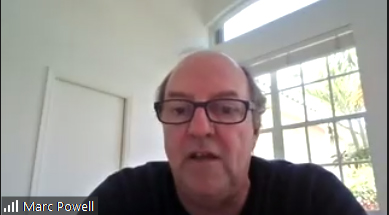
Mr. Powell said that public-private partnerships are a key structure. He said a first step is to build a detailed map of the drivers, cost of capital, service gaps, demographics and potential revenues, and examine how the economics would work for the private sector.
Typically this analysis finds that broadband service falls into one of four categories: 1) a community already has service; 2) a community has attractive economics but service is lacking due to permitting or difficulties getting right-of-way, and cities can help make these areas economically attractive by providing right-of-way access for trenching; 3) some communities have marginal economics and those projects fall to the bottom, but if a city groups categories 2+3 in agreements with the private sector, the projects can move ahead; and 4) some communities don’t make economic sense and require public funding to bridge the gap. This analysis drives project success.
Bill Allen invited all cities in LA County to be part of the new LA Digital Equity Action League. If you are interested in joining, please contact Judy Kruger at LAEDC.
Several live polls were conducted. Top barriers identified by the audience were affordable rate plans and infrastructure.
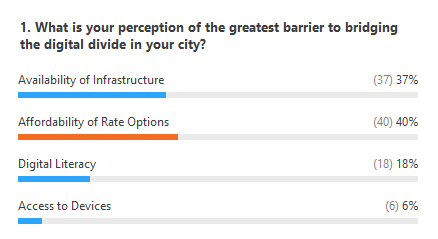
SESSION 2 – LABOR MARKET SOLUTIONS: To Connect Displaced Workers with Training and Hiring Opportunities
Jane Oates, President of Working Nation moderated the discussion.
Jessica Ku Kim, VP, LAEDC: The COVID pandemic laid bare how inequitable our economy has become, and we still have half a million jobs lost during the pandemic that haven’t returned. To solve some of the fundamental issues, collaborative effort is needed to support career training and advancement that is industry-driven, equitable and sustainable, and partnerships are needed to help people access reskilling and training opportunities. M. Kim asked the cities to invest in workforce training partnerships with employers, using on-the-job training, apprenticeships and more models to help address the scale of the problem. LAEDC can help city staff design those programs and hopes to partner with you. (contact Jessica Ku Kim about this)
Otto Solórzano, Acting Director, Department of Workforce Development, Aging, and Community Services (WDACS), LA County: Mr. Solórzano emphasized getting to know the agency system, and the America’s Job Centers (AJCC). Building those relationships is vital for city staff. The AJCCs are employment hubs that bring together employers, job-seekers, training institutions and other government institutions and the economic development department. Through the AJCCs, these participants form an integrated team related to job placement. Many job seekers coming to the AJCCs needing help identifying jobs and sometimes require a lot of hand holding. The AJCCs target extra assistance to veterans, people who have been justice involved, those receiving public assistance and those facing barriers to employment.
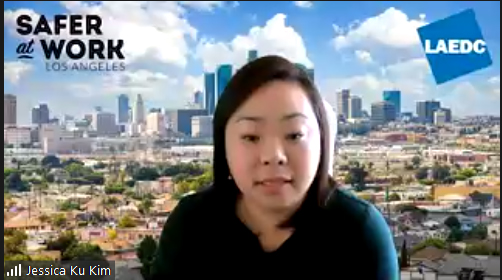
Jessica Ku Kim
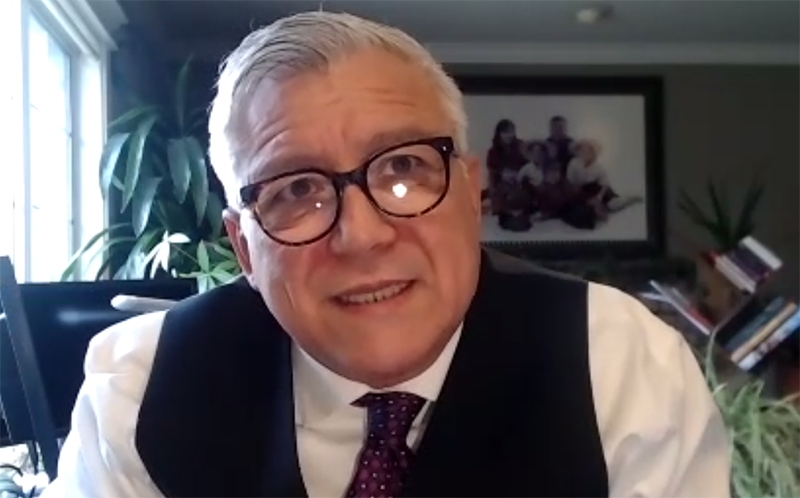
Otto Solórzano
Mr. Solórzano presented a few examples of cities getting value from this partnership. In aerospace, both Cities of Palmdale and Lancaster are working with the AJCCs to provide thousands of jobs to residents working with employer Northrop Grumman and utilizing Antelope Valley College and College of the Canyons, with an emphasis on hiring more veterans.
In City of Industry, the AJCC partnered with Proterra, a large and growing electric bus manufacturer. Proterra worked with the AJCC to create training cohorts to hire veterans and other priority job-seekers, and they partnered with Mt San Antonio College where training was provided.
WDACS can provide economic data on industries within your municipality to help review the data to inform decisions that help residents. WDACS also assists with business licensing, PPE supplies, and the Safer at Work campaign – a partnership between LAEDC and County — to help raise awareness of the importance of people remaining safe in their jobs as the economy reopens.
Amber Meshack, Director, Business, Jobs, & Social Responsibility Division, Los Angeles World Airports (LAWA): Ms. Meshack described how LAWA coordinates workforce for a wide range of private businesses and construction contractors that operate out of LAX. She talked about LAWA’s First Source Hiring Program, which consolidates job openings of all the private employers at the airport, to create a database of job-seekers to help with recruitment. LAWA also requires local hire in its contracts. LAWA continues to see a shortage of skilled craft labor, and the HIRELAX pre-apprenticeship program helps those facing barriers to employment access these craft jobs/careers and that helps LAWA. Ms. Meshack also sees a lot of hiring demand for pilots, contract managers, contract administrators, public sector administrators, engineers including civil, environmental, and transportation. LAWA also partners with Year Up to address DEI in hiring.
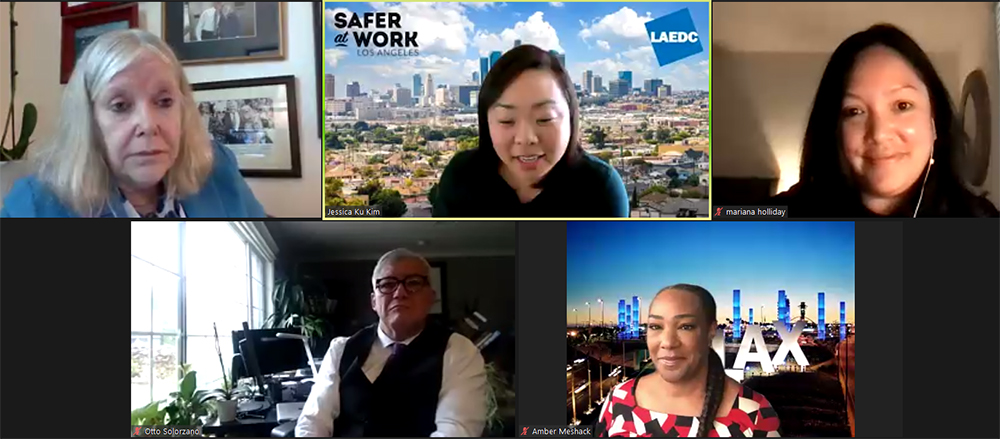
(Clockwise from top left) Jane Oates, Jessica Ku Kim, Marina Holliday, Amber Meshack, Otto Solórzano

Amber Meshack of LAWA
Mariana Holliday, Senior Program Manager, Education to Workforce, Amazon Web Services: Ms. Holliday described the Amazon Web Services (AWS)’s partnership with the 19 community colleges in LA County to offer a certificate program in cloud computing, teaching industry skills that are valued globally, for the top ten roles in cloud computing, with Santa Monica College (SMC) leading the way in the program co-development. The program has now expanded to 16 of 19 local community colleges. Over 5,000 students have graduated from the program in the region, and AWS helps connect students to jobs. This is a global partnership, and this LA model is consistently referenced in our conversations in other countries. She stated that AWS wants to get more cities involved in this effort. Numerous employers have committed to interviewing candidates who have earned these certificates. AWS is also engaging K-12 schools to help kids get an earlier start into these careers. Equity and inclusion are things we can address via education too, with intentionally diverse classrooms.
SESSION 3 – ENTERPRISE SOLUTIONS: Business Reopening, Recovery, Reinvention and Tools Cities Can Use to Help
Stephen Cheung, COO of LAEDC moderated the panel, and opened by saying that our region’s small businesses have suffered during the pandemic and it has impacted entrepreneurs of color particularly hard, worsening racial inequity. He asked, What can the cities do to partner and address this need for business reopening support?
Rafael Carbajal, Director, Department of Consumer and Business Affairs, LA County: Mr. Carbajal said the need is great and therefore partners are essential, including organizations like LISC and its COVID recovery fund. Recently, the Keep the Shops on the Block fund is helping small businesses, but DCBA needs the assistance of cities to reach small businesses to help them access services and funds. DCBA also continues to lever the County’s purchasing power to boost small, local businesses.
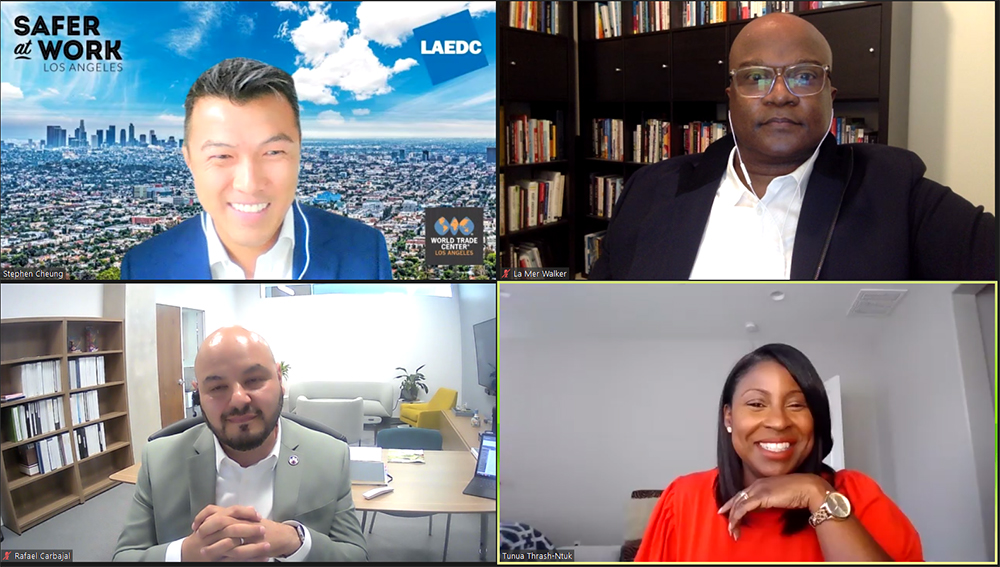
(Clockwise from top left) Stephen Cheung, La Mer Walker, Tunua Thrash-Ntuk, Rafael Carbajal

Tunua Thrash-Ntuk
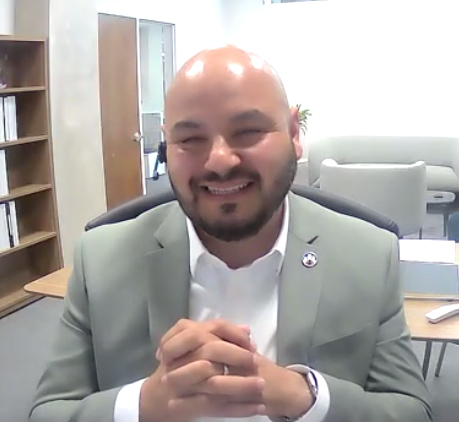
Rafael Carbajal
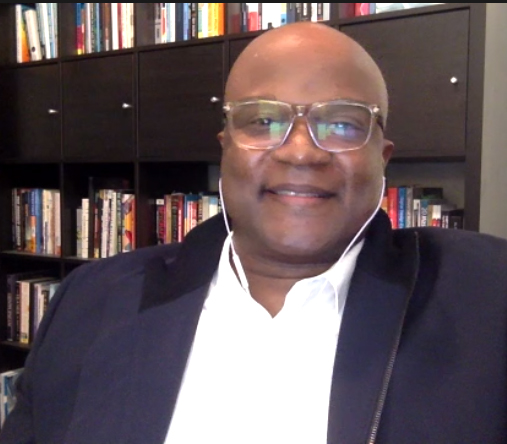
La Mer Walker
Stephen Cheung talked about Safer at Work initiative which was co-developed by LAEDC and LA County, and he gave an overview of LAEDC’s work to provide PPE via PPE Unite, LAEDC’s Community Connectory resource center which aggregates for COVID relief, and LAEDC’s business technical assistance team.
Tunua Thrash-Ntuk, Executive Director, Los Angeles Local Initiatives Support Corporation (LISC LA): Ms. Thrash-Ntuk said that LISC-LA never expected to support the community to the extent that it did this past year. Too many families lost their employment. She talked about her perspective that place, procurement and portals are important. For example, place means neighborhood economic vitality and commercial corridors that need additional push represent an important focus for grants and re-opening support, to help business returning to those neighborhoods. Procurement is an opportunity to support businesses owned by veterans, minorities and women. Portal refers to e-commerce, because businesses saw reduced foot traffic, and she stated that resources at the city level can help small businesses build out that online commerce.
What is your recommendation on how cities can partner to drive equitable and inclusive recovery?
La Mer Walker, Co-Founder & Chief Design Officer, Valence: Valence is focused on working with VCs and they are increasingly interested in creating communities of strength. The engagement has been tremendous, post-George Floyd; that was a trigger for many people to step up as they realized they wanted to be part of the solution in a real way. So, we formed our Valence Funding Network to help open doorways for small businesses and connect Black talent with capital.
Tunua Thrash-Ntuk said the focus on keeping our shops on the block means investing in place and helping community-serving businesses thrive. Those corridors with a BID, chamber or organization that could be invested in by the cities made a difference, especially in providing a database of potential customers in the community. Some businesses found a need to pivot based on the business type, and these organizations helped businesses pivot to address the changes in customer demand and the needs of the community. She also suggested helping entrepreneurs hatch ideas they have created during the pandemic and develop a physical location where the community can engage.
Rafael Carbajal offered DCBA’s small business concierge to help small business understand how to open a new business and said women of color entrepreneurs were some of the hardest hit, so DCBA is supporting them with multiple resources.
Tunua Thrash-Ntuk mentioned City of LA’s LA Optimized, which is helping local entrepreneurs figure out online commerce. She said many businesses need help understanding the need for protection of customer personal identifying information and understanding the need to safeguard customer information and related processes – this education can be part of a city’s program to help their businesses approach this more expertly.
Rafael Carbajal emphasized cities and the County can help businesses build capacity via procurements. A $5,000 contract with a small city can be a stepping stone into a larger contract or county contract or procurement with larger opportunities. He said equity can be improved through these efforts.
What can we do to help women of color entrepreneurs?
Tunua Thrash-Ntuk suggested looking at commercial sectors that have been left behind even before the pandemic. Cities can identify the local champions that care about those areas, and assist those organizations with staffing, infrastructure, training and strategy development, including databases of businesses, customers and audiences they can market to, access to best practices to create events and enthusiasm for their commercial corridor. In addition, she suggested cities can place grants in a way to reduce store vacancies.
Bill Allen closed by thanking the panelists and asking the cities to reach out to LAEDC to explore the ideas presented today.
Thanks to all the cities that are collaborating with LAEDC, and we encourage all our attendees to sign up as members with LAEDC to gain greater access to our resources, to build resiliency and drive recovery.
LAEDC is extending the 88 Cities Summit into a year-round offering of technical solutions to the cities, to offer training, workshops, resources, best practices, data and strategy to make it easier to achieve inclusive and equitable recovery.
—–
Contact LAEDC to learn how our team can help:
Workforce Development, please contact LAEDC’s Claire Anderson.
Business Assistance, please contact LAEDC’s Jessica Ku Kim.
Membership and Strategic Relations with LAEDC, please contact Melissa Kham.
Or refer to our staff page.

